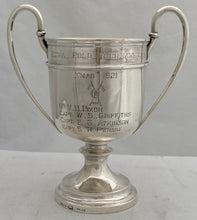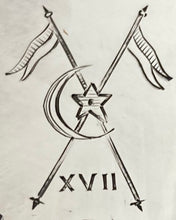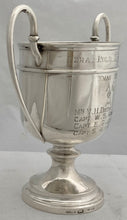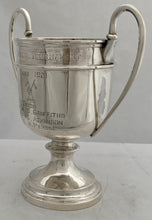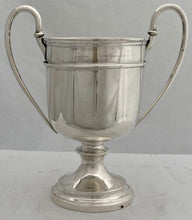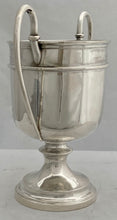
A Colonial Period Indian Silver Presentation Trophy Cup for the 17th Cavalry.
The 17th Cavalry was first raised in 1857 as the Muttrah Horse. Its titles included Muttrah Police Corps (1857-1858), Rohilkhand Auxiliary Police Levy (1858-1859), and then Robart's Horse (1859-1861), before settling as the 17th Regiment of Bengal Cavalry (1861-1882, and 1885-1901). It was briefly known as the 17th Bengal Lancers in 1901 before being renamed as the 17th Cavalry under Lord Kitchener's Indian Army reforms that were completed in 1903.
The regiment arrived in Allahabad at the beginning of 1914, consisting of two squadrons of Punjabi Muslamans, and two squadrons of Pathans. Most of the regiment spent World War One (1914-1918) in India, with detachments at Jhansi, Calcutta, Lahore and Jullundar, however, in 1915 one Pathan squadron was detached for service in East Africa, spending two years in that theatre. By the signing of the Armistice on 11 November 1918, the majority of the regiment had reassembled at Lahore.
In 1919, the regiment was deployed to the 3rd Afghan War and earned the battle honour 'Afghanistan 1919'. In 1921, it amalgamated with 37th Lancers (Baluch Horse) to form 17th/37th Lancers but this combined regiment was renamed the 15th Lancers in 1922.
This cup was presented at the Christmas 1921 Ezra Polo Tournament. The names on the cup are:
Mr V. H. Dixon.
Captain W. S. Griffiths (William Stanley Griffiths): On 8/11/1917, while serving as a 2nd Lieut. with the Yeomanry Cavalry of Worcestershire, he was wounded during the charge at Huj, Gaza. He subsequently joined the 41st Indian Cavalry Regiment as an acting Captain and then the 17th Cavalry as Captain.
Captain E. G. Atkinson (later Colonel Eric Garnett Atkinson 1887 - 1955). Born in India he served as Aide De Camp to the Governor of Madras from 1912-13. He served in France and Belgium during World War One and was mentioned in Dispatches. Further mentioned in Dispatches for service in Afghanistan and Waziristan. He retired to Devon and became a polo umpire.
Captain S. H. Persse (later Brigadier Sydney Henry Persse 1897 - 1945). He joined the London Regiment as a 2nd Lieut. before joining the Indian Army Cavalry. In 1945 he was awarded the Distinguished Service Order (DSO) whilst serving in Burma with the Indian Armoured Corps as a Lieut. Col., acting Brigadier.
Marked to the foot rim for Hamilton & Co. Indian silver, circa 1921.
In excellent condition with light surface wear commensurate with age.
Approximate weight is 260 grams or 8.3 troy ounces.
Approximate dimensions are 14.5 cm height, 13 cm handle to handle length and 7.5 cm top rim diameter.









